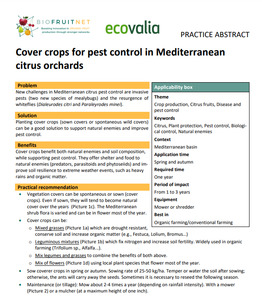{Tool} Cover crops for pest control in Mediterranean citrus orchards (BIOFRUITNET Practice Abstract). Creator(s): Vercher Aznar, Rosa. Issuing Organisation(s): Ecovalia - Asociación Valor Ecológico. Biofruitnet Practice Abstract, no. 094. (2022)
|
PDF
- Published Version
- English
(Cover crops for pest control in Mediterranean citrus orchards)
473kB | |
|
PDF
- Published Version
- Spanish/Español
(Cubiertas vegetales para el control de plagas en cítricos mediterráneos)
473kB | |
![[thumbnail of 2023-04-27 16_33_24-Cover crops for pest control in Mediterranean citrus orchards.png]](/44866/5.hassmallThumbnailVersion/2023-04-27%2016_33_24-Cover%20crops%20for%20pest%20control%20in%20Mediterranean%20citrus%20orchards.png)  Preview |
Image (PNG)
- Cover Image
- English
101kB |
Document available online at: https://orgprints.org/44866
Summary in the original language of the document
Cover crops benefit both natural enemies and soil composition, while supporting pest control. They offer shelter and food to natural enemies (predators, parasitoids and phytoseiids) and improve soil resilience to extreme weather events, such as heavy rains and organic matter.
Practical recommendation
• Vegetation covers can be spontaneous or sown (cover crops). Even if sown, they will tend to become natural cover over the years (Picture 1c). The Mediterranean shrub flora is varied and can be in flower most of the year.
• Cover crops can be:
o Mixed grasses (Picture 1a) which are drought resistant, conserve soil and increase organic matter (e.g., Festuca, Lolium, Bromus…)
o Leguminous mixtures (Picture 1b) which fix nitrogen and increase soil fertility. Widely used in organic farming (Trifolium sp., Alfalfa...).
o Mix legumes and grasses to combine the benefits of both above.
o Mix of flowers (Picture 1d) using local plant species that flower most of the year.
• Sow coverer crops in spring or autumn. Sowing rate of 25-50 kg/ha. Temper or water the soil after sowing; otherwise, the ants will carry away the seeds. Sometimes it is necessary to reseed the following season.
• Maintenance (or tillage): Mow about 2-4 times a year (depending on rainfall intensity). With a mower (Picture 2) or a mulcher (at a maximum height of one inch).
| EPrint Type: | Practice tool |
|---|---|
| What problem does the tool address?: | New challenges in Mediterranean citrus pest control are invasive pests (two new species of mealybugs) and the resurgence of whiteflies (Dialeurodes citri and Paraleyrodes minei). |
| What solution does the tool offer?: | Planting cover crops (sown covers or spontaneous wild covers) can be a good solution to support natural enemies and improve pest control. |
| Country: | Spain |
| Type of Practice Tool: | Practice abstracts |
| Keywords: | Citrus, Plant protection, Pest control, Biological control, Natural enemies |
| Agrovoc keywords: | Language Value URI English Citrus http://aims.fao.org/aos/agrovoc/c_1637 English plant protection http://aims.fao.org/aos/agrovoc/c_5978 English pest control http://aims.fao.org/aos/agrovoc/c_5726 English biological control http://aims.fao.org/aos/agrovoc/c_918 English natural enemies http://aims.fao.org/aos/agrovoc/c_5085 |
| Subjects: | Crop husbandry > Production systems > Fruit and berries Crop husbandry > Crop health, quality, protection |
| Research affiliation: | European Union > Horizon 2020 > Biofruitnet Spain > Other organizations Spain European Union > Organic Farm Knowledge |
| Horizon Europe or H2020 Grant Agreement Number: | 862850 |
| Related Links: | https://organic-farmknowledge.org/tool/44866, https://biofruitnet.eu |
| Project ID: | ofk |
| Deposited By: | Basler, Andreas |
| ID Code: | 44866 |
| Deposited On: | 10 Dec 2022 17:48 |
| Last Modified: | 02 May 2024 10:32 |
| Document Language: | English, Spanish/Español |
| Status: | Published |
Repository Staff Only: item control page

 Download Statistics
Download Statistics Download Statistics
Download Statistics
